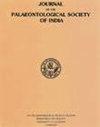印度南部Cauvery盆地上白垩统Sillakudi组相、迹化石及其古环境意义
IF 0.6
4区 地球科学
Q4 PALEONTOLOGY
Journal of the Palaeontological Society of India
Pub Date : 2023-11-14
DOI:10.1177/05529360231205315
引用次数: 0
摘要
西拉库地组是一个以不整合面为界的砂岩为主的序列。它代表了坎帕期在完全确定的被动边缘沉积条件下沉积的阿里亚鲁尔群中最古老的单元。本研究试图根据西拉库底组的微量化石含量,结合沉积学证据,对其沉积古环境进行解释。详细的沉积学和技术观察是在横跨西拉库地组的多个穿越点和地点进行的。西拉库底组可划分为四个相组,每个相组都代表着不同的沉积技术和沉积环境。第1单元由砾岩组成,这些砾岩向上递变为含砾砂岩,除了一些Planolites isp外,几乎没有任何化石痕迹。表明这是一个高能的前滨-滨面环境。第2单元由海绿石砂岩组成,其中有Ophiomorpha nodosa, O. annulata, Thalassinoides isp。和斯科利索线相,属于斯科利索相,表明沉积在滨向海过渡环境中。第3单元包括卵石到颗粒非常粗的块状砂岩,其特征是几乎单一的斯科利索斯岩相,表明三角洲前缘伴生泥石流中床的快速定殖,钙质砂岩与粘土岩交替存在,包含多种克鲁齐亚纳岩相,其岩石组合包括Trichichnus isp。,斑纹棘虫,斑纹棘虫,脊椎棘虫,管状古棘虫,贝弗利扁石器,山棘虫,带绦虫。,海蛸,蛇胚目;,球粒陨石。和Phycodes isp。,指出沉积在较平静的,可能是缺氧的外陆架原生三角洲环境。第4单元有卵石和砂质交错层状砂岩,显示了Thalassinoides isp网络的发展。和蛇麻草。,表明浅层潮下至潮间带的沉积条件。整体演替被解释为先加深后变浅。本文章由计算机程序翻译,如有差异,请以英文原文为准。
Facies and trace fossils of the Upper Cretaceous Sillakudi Formation (Cauvery Basin, S. India) and their palaeoenvironmental significance
The Sillakudi Formation is a sandstone-dominated succession bounded by unconformities. It represents the oldest unit of the Ariyalur Group deposited during the Campanian under fully established passive margin depositional conditions. The present study is an attempt to interpret the depositional palaeoenvironment of Sillakudi Formation based on its trace fossil content, supported by sedimentological evidences. Detailed sedimentological and ichnological observations were undertaken in multiple traverses and spot locations across the Sillakudi Formation. The Sillakudi Formation is subdivided into four facies associations, each represented by a distinct ichnology and environment of deposition. Unit 1 comprises conglomerates grading upwards into pebbly sandstones almost devoid of trace fossils except a few Planolites isp. indicating a high-energy foreshore-to-shoreface environment. Unit 2 consists of glauconitic sandstones with Ophiomorpha nodosa, O. annulata, Thalassinoides isp. and Skolithos linearis, belonging to the Skolithos ichnofacies indicating deposition in shoreface to offshore transition environments. Unit 3 comprises pebbly to very coarse-grained massive sandstones, characterised by an almost monospecific Skolithos ichnofacies indicating rapid colonisation of beds in a delta-front associated debris flows and calcareous sandstones alternating with claystones containing a diverse Cruziana ichnofacies with an ichnoassemblage comprising of Trichichnus isp., Scolicia prisca var. laminites, S. ?prisca, S. vertebralis, Palaeophycus tubularis, Planolites beverleyensis, P. montanus, Taenidium isp., Thalassinoides suevicus, Ophiomorpha isp., Chondrites isp. and Phycodes isp., pointing towards deposition in calmer, possibly dysoxic outer shelf prodeltaic environments. Unit 4 has pebbly to gritty cross-bedded sandstones exhibiting the development of networks of Thalassinoides isp. and Ophiomorpha isp., indicating shallow sub-tidal to intertidal conditions of deposition. The overall succession is interpreted to show initial deepening followed by shallowing.
求助全文
通过发布文献求助,成功后即可免费获取论文全文。
去求助
来源期刊

Journal of the Palaeontological Society of India
PALEONTOLOGY-
CiteScore
1.10
自引率
16.70%
发文量
0
期刊介绍:
The journal is devoted to the publication of original papers and review articles dealing with all aspects of Paleontology, Paleobotany, Stratigraphy, Geochronology, Anthropology and Pre-history.
 求助内容:
求助内容: 应助结果提醒方式:
应助结果提醒方式:


